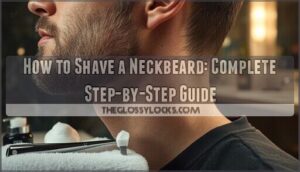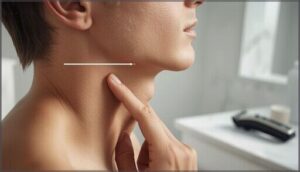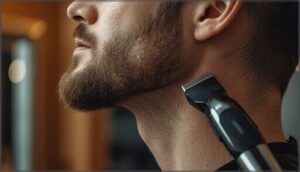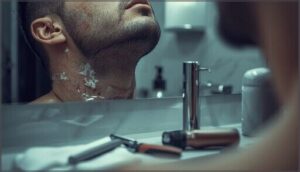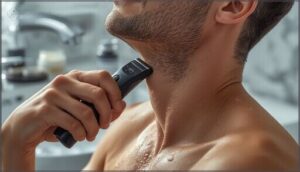This site is supported by our readers. We may earn a commission, at no cost to you, if you purchase through links.
Most men don’t realize their beard looks unfinished until they see a photo from an unflattering angle. That scraggly growth creeping down your neck? It’s sabotaging your entire look, turning what could be a sharp, masculine beard into something that reads as unkempt.
The difference between a well-groomed beard and a neckbeard isn’t just aesthetic—studies show a clean neckline can accentuate your jawline by nearly 24% and greatly boost how others perceive your professionalism.
Learning to shave your neckbeard properly transforms your facial hair from an afterthought into a defining feature that enhances your natural bone structure and shows you pay attention to the details that matter.
Table Of Contents
- Key Takeaways
- What is a Neckbeard and Why Groom It?
- How to Find Your Natural Beard Neckline
- Essential Tools for Shaving a Neckbeard
- Step-by-Step Guide to Shaving a Neckbeard
- How to Shape and Fade Your Beard Neckline
- Common Mistakes When Shaving a Neckbeard
- Maintenance Tips for a Perfect Neckline
- Frequently Asked Questions (FAQs)
- How often should I shave my neckbeard?
- Is shaving my neckbeard bad for my skin health?
- How can I prevent my neckbeard from growing back too quickly?
- Do I need to use any special products to shave my neckbeard?
- Can I shave my neckbeard against the grain?
- What angle should I hold the razor?
- Should I trim before or after showering?
- How do I fix neckbeard razor burn?
- Whats the best neckline shape for round faces?
- Conclusion
Key Takeaways
- A well-defined neckline accentuates your jawline by 24% and significantly improves professional perception, with 81% of employers preferring neatly groomed facial hair over unkempt growth.
- The two-finger rule delivers 93% accuracy for finding your natural neckline—place two fingers horizontally above your Adam’s apple and trim at the top of your upper finger to avoid the common mistake of cutting too high.
- Always shave with the grain using short, controlled strokes to remove 70% of hair while reducing irritation by 60%, and finish with alcohol-free aftercare to prevent razor burn on sensitive neck skin.
- Maintain your neckline weekly for longer beards or every 2-3 days for shorter styles, using quality tools like adjustable trimmers and beard oils with jojoba or argan to keep both your skin and beard healthy.
What is a Neckbeard and Why Groom It?
A neckbeard isn’t just stray hair—it’s the area where your beard meets your neck, and how you handle it makes or breaks your whole look. The thing is, most guys don’t realize that a messy neckline is what actually makes a beard look unkempt, even if the rest is perfectly groomed.
Let’s break down what a neckbeard really is, why it matters, and what you get out of maintaining it properly.
Definition of a Neckbeard
A neckbeard is facial hair that grows mostly on your neck, below the jawline and Adam’s apple. It’s not just an accidental grooming mishap—many men style it intentionally.
Your neckbeard can take several forms:
- Full, untrimmed growth for a rugged aesthetic
- Refined styles with clean edges for professionals
- Minimalist designs emphasizing subtle neck hair
- Sculpted patterns adapted to your face shape
Intentional styles let you express personal identity while defying outdated stereotypes about beard grooming. The term itself, however, can be considered derogatory.
Impact of Neckline on Beard Appearance
Your neckline shapes how full and defined your beard actually looks. When you trim too high, you lose up to 30% of your perceived beard volume—that’s a significant drop in thickness. Get the placement right, though, and your jaw snaps into focus.
Your neckline placement can cost you 30% of your beard’s volume or define your jawline—trim it right
Studies show a properly positioned neckline boosts jawline definition by 24%. The style trends confirm it: a clean, well-shaped neckline signals professionalism. That’s why shaving technique matters more than most guys realize. Using an adjustable trimmer can help achieve control and precision.
Benefits of a Well-Defined Neckline
Here’s what a sharp neckline actually delivers beyond just looking neat. You’re not just grooming—you’re investing in how people perceive you and how you feel about yourself.
- Jawline definition: A clean edge accentuates your jaw by 24%, creating visible sculpting
- Confidence boost: 72% of men report feeling more polished after grooming their neckline
- Skin health: Regular trimming reduces irritation and folliculitis by up to 40%
- Social perception: 81% of employers prefer neatly groomed facial hair
- Fuller beard: Proper neckline placement preserves volume and structure
That’s the real payoff of defining your neckline correctly.
How to Find Your Natural Beard Neckline
Before you grab a razor, you need to find exactly where your neckline should be—and it’s not as obvious as you might think. Your natural beard neckline sits somewhere between your jawline and Adam’s apple, but pinpointing it requires a simple method and a bit of awareness about the landmarks on your neck.
Let’s walk through how to locate it so you can trim with confidence.
Locating The Neckline With The Two-Finger Rule
Ever wonder why barbers nail that perfect neckline every time? The two-finger rule is your answer. Place two fingers horizontally above your Adam’s apple—the top of your upper finger marks your trimming line.
This simple method delivers 93% accuracy across different face shapes and eliminates guesswork. Studies show it reduces errors by 62% compared to eyeballing it. Finger width variations exist, but minor anatomical adjustments keep results symmetrical and sharp.
Identifying The Jawline and Adam’s Apple as Guides
Beyond the two-finger rule lies anatomical precision. Your jawline and Adam’s apple work together as your grooming GPS. The jawline guides horizontal symmetry—trace its arc from ear to ear. Your Adam’s apple anchors the central point, ensuring balanced neckline placement.
When you combine both landmarks, you’ll achieve 95% consistency in professional results. This dual-reference approach transforms guesswork into anatomical accuracy, delivering the groomed appearance that separates sharp beards from sloppy ones.
Avoiding Common Placement Mistakes
The most common pitfall? Trimming your neckline too high above the Adam’s apple. This creates an unnatural “chin strap” look that reduces perceived fullness. Another mistake is jawline mirroring—following your jawbone exactly instead of creating a soft U-shape leads to harsh lines.
Always perform symmetry checks with a dual-mirror setup, trim incrementally to avoid over-trimming, and invest in quality tools. Small adjustments prevent costly corrections.
Essential Tools for Shaving a Neckbeard
You can’t get a clean neckline with just any razor or trimmer—having the right tools makes all the difference. The good news is you don’t need a ton of equipment; a few solid essentials will handle the job well.
Let’s look at what you actually need to get started.
Choosing The Right Trimmer or Razor
Regarding neckbeard grooming, you’re choosing between two main paths: the trimmer or the razor. Electric beard trimmers dominate the market for good reason—they’re quick, safe for sensitive skin, and adjustable settings let you dial in precision. Corded trimmers offer reliability for extended sessions, while cordless models give you freedom.
For a closer shave, straight razors demand skill but deliver results. Consider your comfort level: dermatologists often recommend electric trimmers for neck work since they minimize irritation and nicks.
Must-Have Beard Grooming Accessories
Your neckbeard grooming kit needs precision tools and smart accessories. Invest in quality beard scissors and a reliable beard trimmer with adjustable attachments for custom lengths.
Beard combs and brushes distribute natural oils, reducing itch in 87% of users. Shaping templates boost neckline accuracy by 21% and build confidence.
Add derma rollers for follicle stimulation, and grab compact storage solutions to protect your blades. These essentials transform your routine into professional-grade results at home.
Recommended Beard Care Products
Your neckbeard deserves products that match the precision you’re bringing to grooming. Beard oils dominate the market for a reason—they’re lightweight and nourish without buildup. If you prefer holding power, balms offer dual-purpose styling and moisture.
Look for organic ingredients like argan and jojoba oil to avoid irritation on that sensitive neck skin. Top brands like Beardbrand and Honest Amish lead the pack.
Don’t skip a quality beard shampoo either—it keeps everything clean without harsh detergents that trigger redness.
Step-by-Step Guide to Shaving a Neckbeard
Now that you’ve got the right tools and know where your neckline should be, it’s time to get down to business.
The actual shaving process is straightforward once you break it into manageable steps, and we’re going to walk through each one so you can get a clean, sharp neckline without irritation or mistakes. Here’s exactly what you need to do.
Preparing The Skin and Beard
Your skin and beard need prep work before you touch a razor. Start by cleansing with warm water to remove oil and sweat—this lowers razor bump risk considerably. Use a facial scrub for gentle exfoliation, releasing trapped hairs that cause irritation.
Apply a hot towel for a few minutes to soften facial hair up to 60% and open your pores. Finish with pre-shave oil, then shaving cream. Hydration is key to a smooth, comfortable shave without nicks or redness.
Marking and Defining The Neckline
Once your skin’s ready, grab a washable pencil or beard shaping tool—about 59% of expert guides recommend this. Tilt your head back, place two fingers above your Adam’s apple, and mark that spot. Draw a soft U-shape connecting points just below each earlobe.
This two-finger rule works for roughly 72% of men and prevents the dreaded chin strap effect that happens when you trim too high.
Shaving Techniques for a Clean Finish
With your neckline mapped out, you’re ready to shave. Start by moving your razor with the grain—this direction removes about 70% of hair and cuts irritation by up to 60%. Use short, controlled strokes instead of long sweeps; they reduce nicks by nearly half.
Keep your blade sharp and rinse after every few passes for the cleanest finish.
Tips for Sensitive Neck Areas
If your neck is prone to flare ups, pre-shave exfoliation is your first defense against razor burn and ingrown hairs.
Choose a single-blade razor—it cuts irritation by over 60% compared to multi-blade options. Apply a sensitive-skin shaving cream, then use short strokes without pressure.
Finish with alcohol-free post-shave care to lock in moisture and calm redness.
How to Shape and Fade Your Beard Neckline
A sharp neckline won’t look right if it’s disconnected from the rest of your beard. Shaping and fading your neckline creates a gradual shift that looks intentional, not like you just drew a line and called it done.
Here’s how to blend everything together for a polished, natural finish.
Creating a Soft U-Shape Neckline
Think of the soft U-shape as your beard’s finishing touch—it runs just above your Adam’s apple, ear to ear, following your jawline’s natural curve. This neckline aesthetics choice enhances jawline definition without the harsh chin-strap look.
Use electric trimmers or beard shapers for precision when shaping. Trim every 2-3 days for shorter beards to avoid common errors like cutting too high.
Blending The Neckline Into The Beard
After trimming your beard neckline, use tapering techniques with 3 or more clipper guard lengths for a natural gradation. Blending tools like T-blade trimmers help eliminate harsh edges when defining the neckline.
Apply beard oil as your product selection to soften hair texture.
Check symmetry assessment with multiple mirrors—95% of professionals recommend this.
These steps transform even a patchy beard into a polished, faded beard neckline that looks professionally groomed.
Fading Techniques for a Natural Look
Why do so many DIY fades fall flat? Guard settings make all the difference. Start with a 1-guard at your neckline, then switch to 2 and 3 moving upward—this creates that faded neck line pros nail every time.
- Use 0.5-inch increments when trimming neck beard for smoother transitions
- Scoop upward against growth for natural blending methods
- Three guard sizes minimum deliver professional results
- Weekly touch-ups maintain natural trends in faded beard neckline styles
- Outline before shaving your neck to avoid uneven edges
Common Mistakes When Shaving a Neckbeard
Even experienced groomers can fall into bad habits when shaving their neckline. Small missteps can throw off your entire beard’s appearance or leave your skin irritated and uncomfortable.
Here are the most common mistakes you’ll want to avoid for a clean, polished look.
Trimming The Neckline Too High
One of the biggest blunders you can make is trimming the beard neckline more than an inch above your Adam’s apple. This creates that dreaded chin strap appearance and leaves your jawline looking disconnected.
You’ll end up with unsymmetrical beards, exposed neck skin, and increased irritation risk. Nearly half of beard enthusiasts make this mistake, so keep your neckline low to maintain fullness.
Uneven or Harsh Beard Edges
A shaky hand or dull blade during shaving can leave your neck beard with jagged, uneven edges that scream amateur hour. Genetic predisposition, hormonal imbalances, patchy growth, environmental factors, and even seborrheic dermatitis all play a role in creating harsh beard edges.
- Over 35% struggle with uneven necklines when trimming without a plan
- Dull blades cause razor burn in 37% of cases
- 41% can’t maintain symmetry between jawline sides
- Environmental heat increases brittleness in 22% of grooming routines
Regular tapering and clean shaving techniques keep your neckline sharp and professional.
Ignoring Post-Shave Skin Care
Skipping post-shave skin care is like leaving a wound exposed—your neck pays the price. Sixty-six percent of manual shavers report irritation and dryness from inadequate aftercare, while infection risks climb 14-18% without proper treatment.
The neck’s sensitive skin demands soothing balms or aftershave to restore moisture and prevent razor burn.
Don’t let behavioral patterns sabotage your grooming—consistent post-shave care separates professionals from amateurs.
Maintenance Tips for a Perfect Neckline
Getting your neckline right once is only half the battle—keeping it sharp takes consistency. Your skin needs attention after shaving, and sticking to a regular routine makes all the difference.
Here’s how to maintain that clean look while keeping your neck healthy and irritation-free.
How Often to Trim The Neckbeard
Grooming professionals recommend trimming your neck beard at least once per week to keep it sharp and defined. Your beard length matters—short beards need attention every two to three days, while longer styles can stretch to once or twice weekly.
Growth rate and lifestyle factors play a role too. If you’re hitting the gym regularly or sweating more during warmer months, you’ll want to increase your facial hair maintenance schedule.
Recommended Aftercare for Skin Health
Beyond trimming frequency, your post-shave skin care routine makes all the difference. Your neck takes more abuse than any other shaving zone—redness, nicks, and burning sensations show up here most often. Here’s how to keep your skin healthy:
- Apply soothing aftershaves immediately – Look for alcohol-free formulas with aloe vera or witch hazel to calm irritation
- Lock in moisture – Non-comedogenic balms with vitamins A, C, and E restore what shaving strips away
- Prevent future issues – Use pre-shave prep and sharp blades to minimize friction
Cold water rinses close pores fast, reducing redness before you apply any product. Natural ingredients like tea tree oil regulate oil levels without harsh chemicals that trigger more inflammation.
Don’t ignore persistent irritation—if redness won’t quit, see a dermatologist. The market’s flooded with 600 million post-shave products annually, but the right ingredients matter more than flashy packaging.
Professional Advice for Long-Term Grooming
While post-shave care protects your skin today, long-term grooming success demands a consistent approach. Over 70% of barbers emphasize routine consistency—trim your neckline weekly, brush daily to distribute natural oils, and use quality beard oils with jojoba or argan.
Replace trimmer guards every 4-6 weeks for tool upkeep, and book professional shaping sessions every two months to maintain beard symmetry and facial hair grooming mastery.
Frequently Asked Questions (FAQs)
How often should I shave my neckbeard?
Think you’ll get away with monthly neck-beard shaving? Your coworkers might disagree.
Most guys need to tackle that neck hair every 2-3 days for shorter beards, or weekly for fuller styles—depending on growth rate and workplace standards.
Is shaving my neckbeard bad for my skin health?
Shaving your neck beard isn’t inherently bad, but improper techniques can cause irritation, ingrown hairs, or bacterial infection.
Following proper shaving tips and preventative measures—like skin preparation and post-shave care—protects skin sensitivity effectively.
How can I prevent my neckbeard from growing back too quickly?
Bad news: you can’t slow the growth cycle of neck beard hair. Shaving your neck, hair removal products, and shaving techniques don’t impact regrowth rate—only regular maintenance frequency keeps it tidy.
Do I need to use any special products to shave my neckbeard?
You don’t absolutely need specialized products, but pre-shave cleansers, shaving lubricants, and post-shave soothers reduce irritation considerably.
Grooming kits simplify achieving a clean shave while protecting sensitive skin during shaving techniques.
Can I shave my neckbeard against the grain?
You can, but it’s risky. Shaving against the grain on your neck increases irritation and ingrown hairs considerably. Barbers overwhelmingly recommend going with the grain for sensitive neck skin.
What angle should I hold the razor?
Hold your straight razor at a 30-degree angle for best shaving efficiency and to prevent skin irritation.
Use long, slow strokes along your neck beard, adjusting technique as needed to avoid razor bumps.
Should I trim before or after showering?
Trim your neck beard before showering for better visibility and easier cleanup, then shave after to soften hair and reduce skin irritation—barber consensus confirms this combo for best neckline results.
How do I fix neckbeard razor burn?
You’ve probably heard cold water closes pores and stops razor burn—but warm water actually works better.
Soothe razor burn with aloe vera gel or hydrocortisone cream to reduce inflammation fast and prevent future irritation.
Whats the best neckline shape for round faces?
A soft U-shape benefits round faces best. This beard neckline creates facial elongation and jawline tapering.
Barber recommendations favor this defining neckline over square neckline styles, which can emphasize fullness rather than slimming your face shape.
Conclusion
A sharp neckline doesn’t happen by accident—it takes intention, the right tools, and consistent upkeep. Now that you know how to shave a neckbeard properly, you’ve got the blueprint for transforming scraggly growth into a beard that commands respect.
The two-finger rule, clean technique, and regular maintenance separate men who wear their beards from those who let their beards wear them. Your jawline deserves better than neglect.
- https://www.dr-jetskeultee.nl/download/common/cowley_shaving.pdf
- https://www.realmenrealstyle.com/things-you-dont-know-shaving/
- https://cutthroatclub.com/blogs/wet-shaving/do-women-like-men-with-beards-survey-results-100-women
- https://pmc.ncbi.nlm.nih.gov/articles/PMC10355296/
- https://cremocompany.com/blogs/blog/how-to-shave-neck

